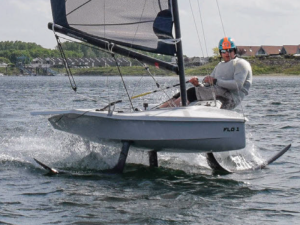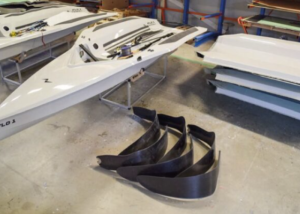Qconcepts article in Jachtbouw Nederland
DOETINCHEM – Most sailors dream of sailing big and fast one day. In an ocean race, for instance. Jurian Rademaker, a Dutch naval architect, had that dream come true and went a step further by taking a step back.
Rademaker crewed on the winner of the 2005-2006 Volvo Ocean Race. In the following years, he worked for different companies in the European yacht racing circuit and, in 2013, founded Qconcepts Design and Engineering, which has developed the Flo1, a one-person foiling sailboat.
Qconcepts designs and builds lightweight structures (yacht deckhouses, for instance) and maritime systems. It is the only Dutch company to have developed a sailing boat with wings that it is marketed internationally through a distributor.
“It’s not difficult to build a very fast hydrofoil boat”
“In the 2013 America’s Cup in San Francisco, the big cats started flying,” says Rademaker. “Nobody thought that was doable within the rules of those 72-footers. So the question arose: ‘how about a foiling sailboat for amateur sailors?”
That led to the Flo1 with a Dynamic Stability System that uses a boat’s forward motion and a retractable foil to increase stability by creating lift. The foil, set to leeward, creates lift that yields stability as the boat skims just above the water. “It’s not difficult to build a very fast hydrofoil boat,” says Rademaker.
“But it must be tamed to be of use for the average sailor. The boat finds its own balance. You need not shift weight like on a kite surfboard. Our wing regulates this itself.”
The foils are sharp, the speeds tremendous. How about safety? Rademaker: “Ultimately, you sail the Flo1 most of the time with the wings in the water. If you fall off, you don’t bump into the foil. On the other hand, it is a high-speed craft and we recommend you wear a helmet. I have done 20 to 21 knots with the Flo1.”
The construction of the Flo1 takes place almost entirely in-house. The sails come from Quantum Sails of the Netherlands. The carbon tube masts are finished by Qconcepts. “We use CNC techniques for everything: milling the slot holes in the masts, cutting the carbon fibers, milling the boat’s foam core and modeling the front end. We also use 3D printing for the pivot points of the wings, the main sheet foot block, inserts for the suspended rudder, the rudder head itself and the scale models.
The Flo1 is currently seen on inland and coastal waters around Germany, France and the Netherlands. Rademaker plans to expand the range and targets an annual production of 20 to 30 boats.
Source: Jachtbouwactueel.nl




